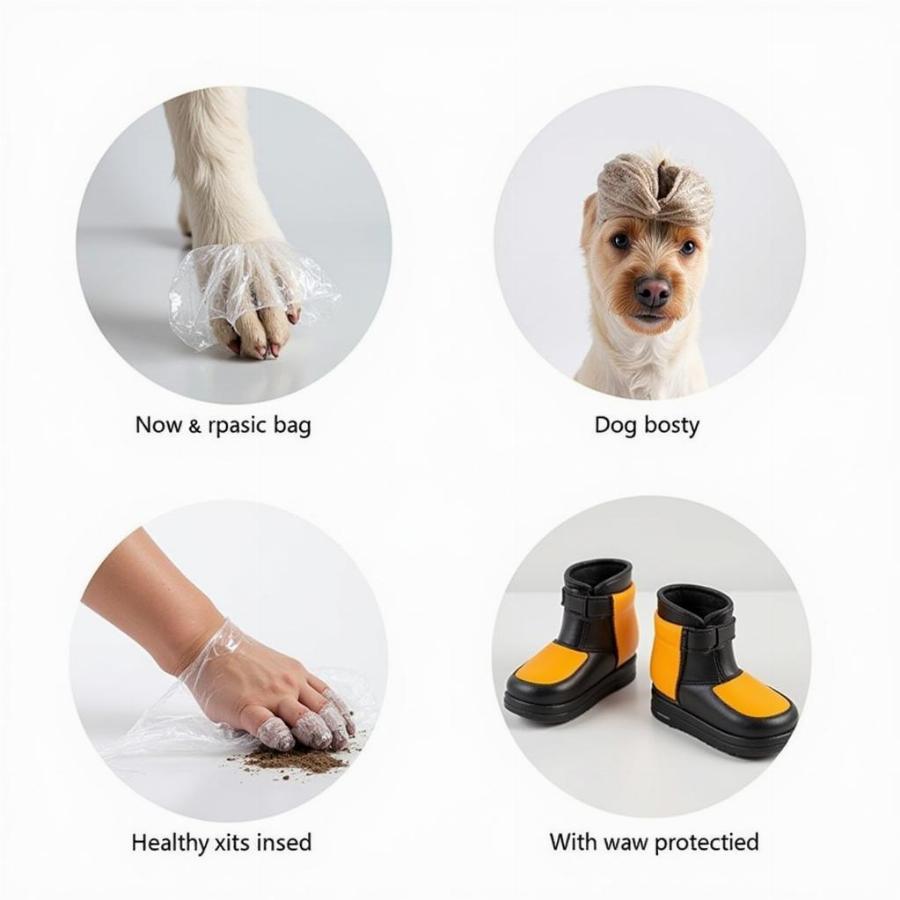Bandaging a dog’s paw can seem daunting, but with the right knowledge and a little practice, it becomes a manageable task. Whether your furry friend has a minor cut, a torn nail, or a more serious injury, knowing how to wrap their paw correctly is crucial for their comfort and healing. This guide will walk you through the process step-by-step, ensuring you can provide the best possible care for your beloved companion.
Understanding the Importance of Proper Paw Wrapping
Before diving into the how-to, let’s discuss why proper paw wrapping is so vital. A correctly wrapped paw protects the wound from further contamination, reduces bleeding, minimizes swelling, and provides support, all of which contribute to faster healing. Conversely, a poorly wrapped paw can restrict blood flow, exacerbate the injury, and even cause further damage.
Gathering Your Supplies
Having all the necessary supplies at hand before you begin will make the process smoother and less stressful for both you and your dog. You’ll need:
- Clean gauze pads
- Non-stick bandages
- Vet wrap (self-adhesive bandage)
- Scissors
- Medical tape (optional)
- Cotton padding (optional, for extra cushioning)
Step-by-Step Guide to Wrapping a Dog’s Paw
- Clean the wound: Gently clean the affected area with antiseptic solution or warm water and mild soap. Pat dry with a clean towel.
- Apply gauze: Place a clean gauze pad directly over the wound. If the wound is bleeding, apply gentle pressure for a few minutes to stop the bleeding before proceeding.
- Secure the gauze: Use a non-stick bandage to secure the gauze pad in place. Ensure it’s snug but not too tight.
- Apply padding (optional): If the wound requires extra cushioning, wrap a layer of cotton padding around the paw over the non-stick bandage.
- Wrap with vet wrap: Start wrapping the vet wrap from the toes, moving upwards towards the leg. Overlap each layer by about half the width of the wrap. Maintain even pressure, avoiding wrapping too tightly.
- Secure the wrap: Secure the end of the vet wrap with medical tape or by tucking it under the previous layer.
- Check for tightness: Ensure the wrap is snug but not constricting. You should be able to slip two fingers between the wrap and your dog’s leg.
When to Seek Veterinary Care
While minor cuts and scrapes can often be managed at home, it’s essential to know when to seek professional veterinary care. Deep wounds, punctures, excessive bleeding, or any signs of infection (such as redness, swelling, pus, or a foul odor) require immediate veterinary attention.
Tips for Keeping the Wrap Clean and Dry
Keeping the wrap clean and dry is crucial for preventing infection and promoting healing. Use a plastic bag or a commercially available paw protector to cover the wrapped paw when your dog goes outside, especially in wet or muddy conditions.
 Bảo vệ chân chó bị thương
Bảo vệ chân chó bị thương
Common Mistakes to Avoid
- Wrapping too tightly: This can restrict blood flow and cause serious complications.
- Wrapping too loosely: A loose wrap can easily slip off and won’t provide adequate protection.
- Using the wrong materials: Avoid using human bandages or adhesive tapes, as these can irritate your dog’s skin.
What if My Dog Licks the Wrap?
Many dogs instinctively lick their wounds, which can interfere with healing and even introduce infection. If your dog is licking the wrap excessively, consider using an Elizabethan collar (also known as a “cone”) to prevent them from reaching the injured paw.
Dr. Emily Carter, DVM, a renowned veterinarian specializing in canine care, emphasizes, “Proper paw wrapping is a crucial first-aid skill for every dog owner. It can significantly impact your pet’s comfort and recovery, and in some cases, even save their life.”
Dr. Michael Davis, DVM, another leading expert in veterinary medicine, adds, “Remember to always monitor the paw for any signs of infection or discomfort. If you notice anything unusual, contact your veterinarian immediately.”
Conclusion
Knowing how to wrap a dog’s paw is a valuable skill for any pet owner. By following the steps outlined in this guide and being mindful of potential complications, you can provide your furry friend with the best possible care and ensure a speedy recovery. Remember, if you are unsure about anything, always consult with your veterinarian.
FAQ
- How often should I change the wrap? Ideally, the wrap should be changed daily or every other day, or as directed by your veterinarian.
- Can I use human bandages on my dog? It’s best to use veterinary-specific bandages and wraps, as these are designed for a dog’s skin and fur.
- My dog keeps licking the wrap, what should I do? Use an Elizabethan collar to prevent your dog from licking the wrap.
- When should I take my dog to the vet? Consult your veterinarian immediately for deep wounds, punctures, excessive bleeding, or any signs of infection.
- How can I keep the wrap dry outside? Use a plastic bag, dog boot, or a commercial paw protector to cover the wrapped paw.
Related Articles
- how to treat a limping dog at home
- dog got a bee sting
- eye medicine for dogs
- how to give a dog the heimlich
Beaut Dogs is your trusted source for all things dog-related, providing expert advice and resources to help you care for your canine companion. From breed information to health tips and product recommendations, we’re here to support you every step of the way. When you need assistance, please contact us via Email: [email protected] to receive detailed and accurate answers from Beaut Dogs. Visit us at https://beautdogs.com to learn more.